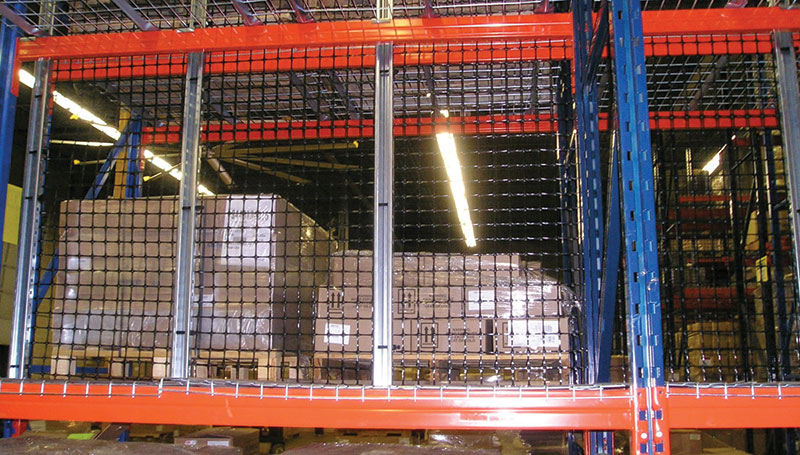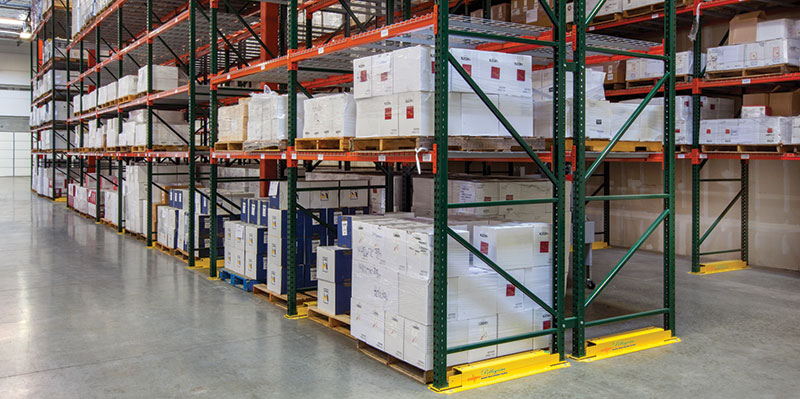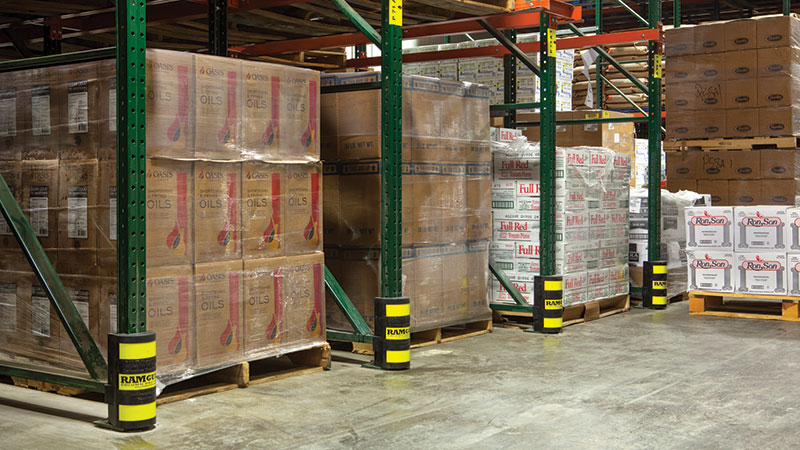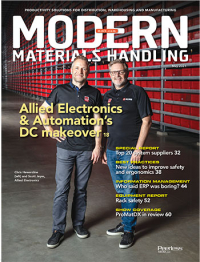Best practices in rack safety
You may only think of racks as a place to store product. But unpack rack safety, and it’s easy to see that it also has an impact on people and equipment in the warehouse.
Every so often, it’s good to have a bit of a refresher course in certain subjects. Rack safety certainly qualifies. So here we go.
The short course is simple. Rack safety is all about protecting people, equipment and product.
Randy Johnson, vice president of sales and marketing at Industrial Netting, expands on that. “Rack safety is about keeping people safe and away from dangerous areas in the warehouse. It’s also about protecting the rack from lift trucks and other warehouse equipment. And it’s about placing and keeping product in the rack so it doesn’t endanger people or equipment.”
There’s a nice safety symmetry to all that. And a direct correlation is there between safe, secure loads in rack and high warehouse productivity. Basically, you can’t have the latter without the former.
Unfortunately, there are plenty of opportunities to compromise rack safety. In fact, unsafe rack ranges from damage to columns and bracing to shelf and decking instability, explains Steve Johnson, vice president of sales at Nashville Wire Products. Combinations of deficiencies such as damaged columns and unsecured loads only exacerbate problems. That doesn’t even bring in the inevitability of poorly placed loads in rack.
Fortunately, several options are available to help get rack safety right. They include core rack design principles from broad specifications to building and fire codes. Then there’s the matter of loading racks properly, which requires matching load configurations to the beams and the wire decking they may rest on. And once loads are in place, it’s important they are secured with netting, wire mesh panels or safety straps that ensure loads don’t shift dangerously. It’s important not to underestimate protecting the racks themselves from damage caused by day-to-day use with various guards and protective barriers.

A new safety standard guides use of angle-framed wire mesh panels to secure what’s stored in racks.
One other factor that directly impacts rack survivability is lift trucks. “Rack systems are not indestructible,” points out Dave Olson, national sales manager for Ridg-U-Rak. He says lift truck operator training has a direct link to how drivers interface with rack and limit potential damage to that equipment.
Clearly rack safety doesn’t just happen.
Getting started with safety
Rack safety starts with system planning. That’s according to the Rack Manufacturers Institute (RMI; see box).
Important considerations here include the geographic and geotechnical conditions at the location of the rack installation. “This impacts the potential need for the rack system to be designed, manufactured and installed to resist earthquake, wind or snow load forces,” explains a recent RMI blog.
Other rack design considerations include the type and variety of goods to be received, stored, picked, packed and shipped from the facility. Their dimensions, weights and particular characteristics are critical factors in rack design.
Also important is the load-handling medium—pallets, slip sheets, skids—used in the facility. There’s also the matter of the types of materials handling equipment, especially lift trucks, that will interface with the racks.
Other factors to consider include the full range of rack types in the facility and the required aisle widths between rack structures. The optimal width of each clear bay within the rack structure requires attention, too, says the RMI blog.
Protecting rack and loads
Two key aspects are important to protecting rack in day-to-day activities. One is the interface of the racks with loads handled by lift trucks and other materials handling equipment. The second is protective equipment from barriers and guards to wire mesh panels and netting that keep loads in place.
Rack that interfaces with automated systems are typically more protected than those that interface with lift trucks. The reason is quite simple: Automated systems follow a set path, while lift truck motions are controlled by the operator and depend entirely on that person’s skills at moving loads.
The basic motion for lift trucks, says Olson, is to lift and remove or simply place loads on the rack beams. Side shifting and similar load moves may compromise rack integrity.
There is also the matter of protecting the racks from collisions with trucks. Options here include steel reinforced rubber guards and column reinforcements, to name two.
Just as important is keeping product secure on racks. The most common types are netting, steel mesh panels and decking.
Just as RMI promotes rack safety, the Protective Guarding Manufacturers Association (ProGMA) is a strong proponent of rack safety, too (see box, p. 56).
Among its activities, the group works to develop industry standards such as the MH 31.1 Wire Mesh Steel Containment Panel Standard, explains ProGMA vice chair Ray Niemeyer, vice president of sales and marketing at SpaceGuard Products. The standard sets impact standards for angle-framed wire mesh panels to secure “the most rigid structure to secure and guard product from falling from rack and decking,” he explains.
Another critical security barrier for loads is netting, explains Johnson of Industrial Netting. “Typically made from extruded polypropylene or knitted nylon or polyester, netting protects product from falling off the rack thus endangering employees. It also prevents possible destruction of the product itself, Johnson explains. “Netting gives people confidence that a load will remain on the rack without falling,” he adds.

It is the responsibility of the owner to ensure rack is properly used and maintained.
Wire decking is yet another rack accessory for securing loads. Johnson of Nashville Wire says that open-mesh steel decking ensures even distribution of a load’s weight over the entire surface of the decking. Channels provide additional support, depending on the weight distribution of the load. As a result, decking allows a broader range of loads to be securely stored in rack.
Also of note are safety straps. As Steve Dew, CEO of Adrian’s Safety Solutions, explains, rack safety straps prevent loads from accidentally being pushed too far back in the location. Beyond protecting people from precariously positioned loads, the polyester straps also keep the load away from the vertical flue space behind rows of racks. Vertical flue spaces allow fire to move vertically toward ceiling sprinklers, setting them off.
“Without the safety straps, it doesn’t take much for a warehouse to inadvertently fill up those flues and endanger their fire safety,” adds Dew.
Inspections and repairs
Clearly, rack safety has many moving parts. Probably the best summary is the presentation made last month at ProMatDX. It’s called “Storage Rack Safety 101” and was presented by Johnson of Nashville Wire, Olson of Ridg-U-Rak and Tom Koontz, director of engineering at Steel King Industries. Delving into that presentation, Olson thought the sections on inspections were particularly critical to rack safety.
Two leading organizations in rack safety
While we spoke to several individuals at rack and guarding companies for this story, they are all part of two organizations that are, at their core, dedicated to promoting safety.
One is the Rack Manufacturers Institute (mhi.org/rmi) and the other is the Protective Guarding Manufacturers Association (mhi.org/progma). Both are affiliated with the trade association MHI.
Each of the organizations speak as a single entity for their individual segments of the materials handling industry. Their members are manufacturers of that equipment.
Both RMI and ProGMA work with national groups to write and set usage and safety standards. They also develop and promote nomenclature for their products, and publish case histories on their use. Perhaps most impressively, members of both groups put aside their competitive differences to promote the safe use of racks and accessories of all types.
Rack inspections come in many different forms. They start with those required by the local building code and related installation inspection. Over the lifetime of the rack, periodic system inspections as well as those for any reconfigurations and repairs are of high importance, says Olson.
He strongly emphasizes that “the owner/operator of the storage rack is responsible for ensuring the rack is properly used and maintained.” If damage occurs, the racks should be immediately unloaded, and left unused until properly repaired or replaced. That said, Olson insists that “everyone in the warehouse has an equal and ongoing responsibility for their co-workers’ safety.”
To ensure that, periodic system inspections are recommended. Particular areas of focus, says Olson, include high traffic areas, zones with high-turn SKUs, narrower aisles, transfer areas such as tunnel bays, end-of-aisles and rack entry points. Depending on circumstances, these areas should be inspected monthly, quarterly or semi-annually.

Guards at the base of racks protect against impact from lift trucks and other materials handling equipment.
On the issue of repairs and replacements, Koontz makes an important distinction. “Replacement is only with identical parts from the original equipment manufacturer. Everything else is repair,” he says. RMI offers a publication called “Guideline for the assessment and repair or replacement of damaged rack.”
A particularly strong emphasis needs to be on engineering and engineers in the repair process, says Koontz. They are required to ensure the repair kit meets the approval of the OEM. Also, the bracing system must be designed in unison with the original frame and system. His final comment is that “the liability for any failure may rest with the owner of the rack.”
Perhaps the final slide in the ProMatDX presentation said it best when it comes to rack safety at your facility: Peace of mind comes with a more durable rack system and a preventive maintenance program.

Article Topics
Racks & Shelving News & Resources
Steele Solutions showcases advanced structural steel platforms and materials handling chutes Frazier shows Pallet Spacing System and Method Steel King Industries announces strategic collaboration with Automha Americas Nucor discusses future rack project Toyota Material Handling receives Manufacturing Excellence award for Community Impact Conventional warehousing update 60 Seconds With Kevin Curry, industry veteran More Racks & ShelvingLatest in Materials Handling
Beckhoff USA opens new office in Austin, Texas Manhattan Associates selects TeamViewer as partner for warehouse vision picking ASME Foundation wins grant for technical workforce development The (Not So) Secret Weapons: How Key Cabinets and Asset Management Lockers Are Changing Supply Chain Operations MODEX C-Suite Interview with Harold Vanasse: The perfect blend of automation and sustainability Consultant and industry leader John M. Hill passes on at age 86 Registration open for Pack Expo International 2024 More Materials HandlingAbout the Author
Subscribe to Materials Handling Magazine

Find out what the world's most innovative companies are doing to improve productivity in their plants and distribution centers.
Start your FREE subscription today.
April 2024 Modern Materials Handling

Latest Resources












